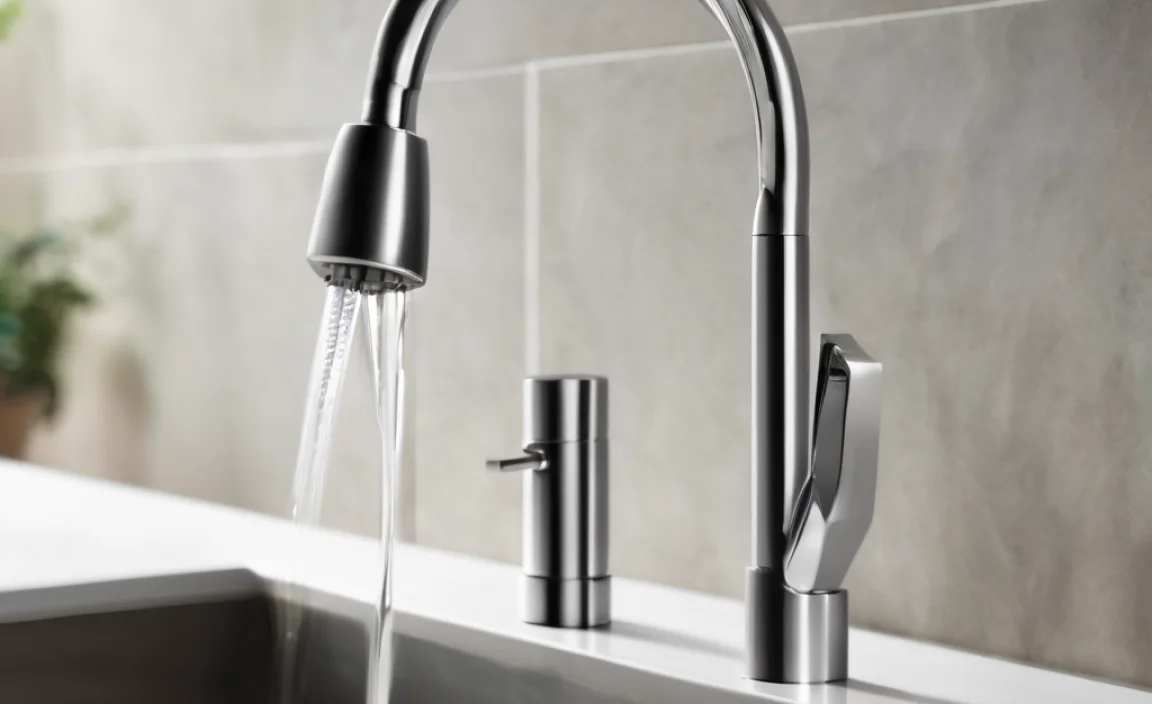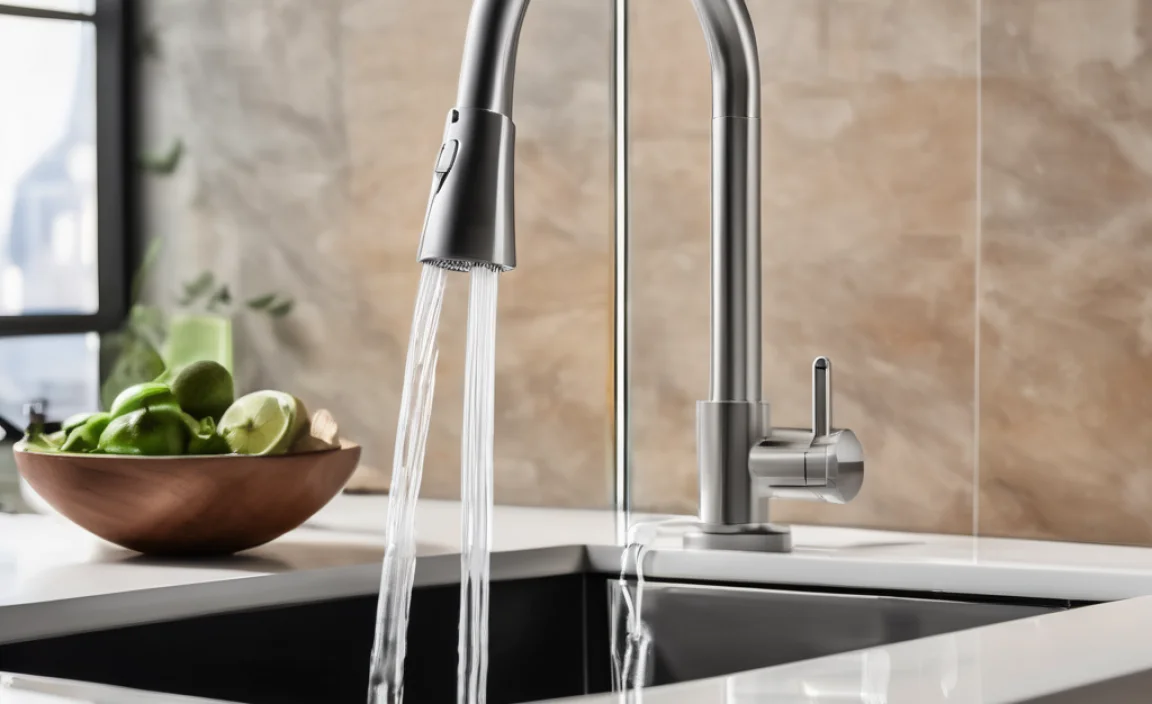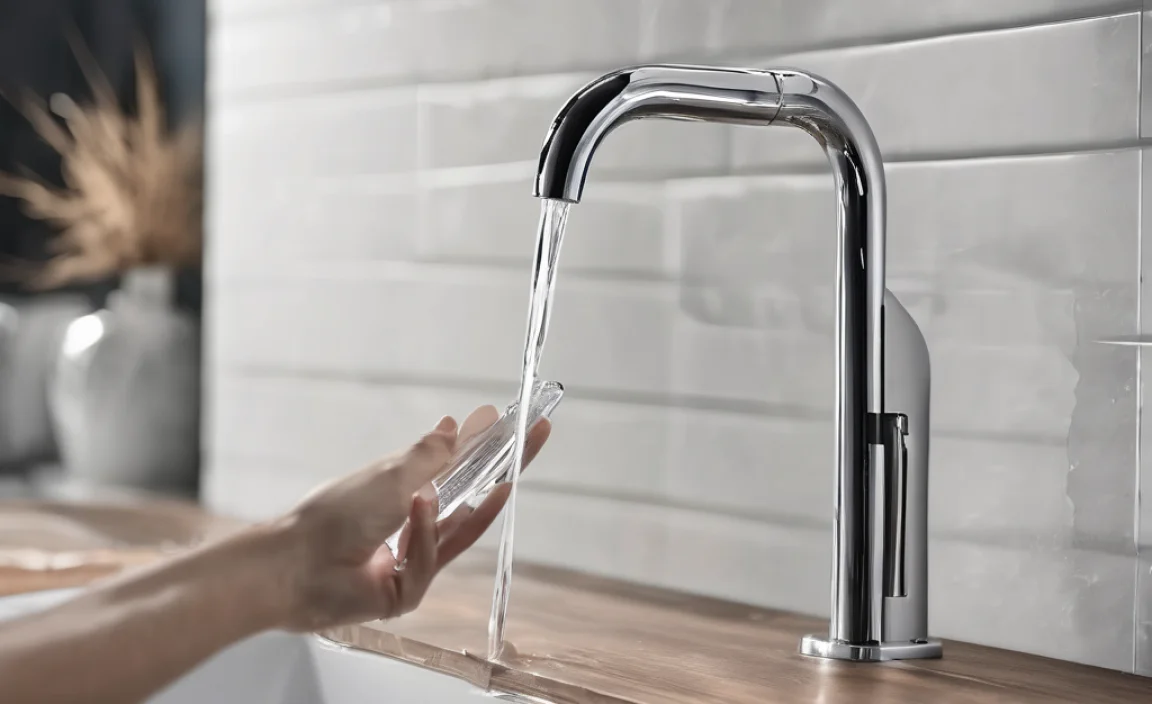Quick answer: Yes, most touchless faucets need a power source to operate. While some models use batteries, many require a standard electrical connection. This power runs the sensor that detects your hands and activates the water flow. Choosing between battery and electric options depends on your plumbing setup and preferences.
Touchless faucets are super handy. You just wave your hands, and the water turns on! No more messy handles or spreading germs. But a big question comes up: do these faucets need electricity? It’s a common question because figuring out the power source can affect where and how you install them.
Understanding the power needs of touchless faucets is key to making the right choice for your home. In this guide, we’ll cover everything you need to know. We’ll look at the different types of power options, how to install them, and even troubleshoot common issues. Ready to dive in? Let’s get started!
Understanding Touchless Faucets

Touchless faucets, also known as automatic or sensor faucets, use technology to turn water on and off without you having to touch anything. These faucets have become really popular in both homes and public places because they’re hygienic and easy to use.
How Do Touchless Faucets Work?
Touchless faucets use an infrared (IR) sensor to detect movement. Here’s how it works:
- Sensor Emits Light: The faucet sends out an invisible beam of infrared light.
- Reflection Detection: When you place your hands near the faucet, the light bounces back to the sensor.
- Activation: The sensor recognizes the reflected light and signals a valve to open. This starts the water flow.
- Automatic Shut-Off: When you remove your hands, the sensor stops detecting the reflection, and the valve closes, turning off the water.
Benefits of Touchless Faucets
- Hygiene: Reduce the spread of germs by not touching the faucet.
- Water Conservation: Automatic shut-off helps prevent water waste.
- Convenience: Easy to use, especially for kids or people with mobility issues.
- Modern Look: Adds a sleek, modern touch to your kitchen or bathroom.
Power Options for Touchless Faucets

Touchless faucets need power to run their sensors and valves. The main power options are:
- Batteries
- AC Power (electricity)
- Hybrid Systems
Battery-Powered Faucets
Battery-powered faucets are a simple and flexible option. Here’s what you need to know:
- How They Work: These faucets run on standard batteries, usually AA or AAA. The batteries power the sensor and valve.
- Installation: Battery-powered faucets are easy to install because you don’t need to connect them to an electrical outlet.
- Battery Life: Battery life varies depending on usage and faucet model, but most last from one to three years.
- Maintenance: You’ll need to check and replace the batteries regularly.
Pros of Battery-Powered Faucets:
- Easy to install, no need for electrical wiring.
- Good for retrofitting existing faucets.
- Work during power outages.
Cons of Battery-Powered Faucets:
- Require regular battery replacements.
- Can be less reliable if batteries aren’t changed on time.
- May not be as powerful as AC-powered models.
AC-Powered Faucets
AC-powered faucets connect directly to your home’s electrical system. Here’s a breakdown:
- How They Work: These faucets plug into a standard electrical outlet, providing a steady power supply.
- Installation: Requires access to an electrical outlet near the faucet. You might need to hire an electrician to install an outlet if there isn’t one nearby.
- Reliability: AC-powered faucets are generally more reliable because they have a constant power source.
- Cost: While the faucet itself might be more expensive, you won’t have the ongoing cost of buying batteries.
Pros of AC-Powered Faucets:
- Reliable, consistent power.
- No need to replace batteries.
- Often more powerful sensors and valves.
Cons of AC-Powered Faucets:
- Require an electrical outlet nearby.
- Installation can be more complex and costly.
- Won’t work during power outages unless you have a backup power source.
Hybrid Systems
Hybrid systems combine the benefits of both battery and AC power. Here’s how they work:
- Functionality: These faucets primarily use AC power but have a battery backup.
- Backup Power: If the power goes out, the faucet automatically switches to battery power, ensuring it continues to work.
- Convenience: Offers the reliability of AC power with the security of battery backup.
Pros of Hybrid Systems:
- Reliable power with a backup.
- Continuous operation even during power outages.
- Convenient and low maintenance.
Cons of Hybrid Systems:
- More expensive than battery-only or AC-only models.
- Still require occasional battery replacement.
- Installation can be more complex.
Installation Guide for Touchless Faucets

Installing a touchless faucet might seem tricky, but with the right steps, you can do it yourself. Here’s a general guide. Remember to always follow the manufacturer’s instructions for your specific model.
Tools You’ll Need
- Adjustable wrench
- Basin wrench
- Plumber’s tape
- Screwdriver (Phillips and flathead)
- Measuring tape
- Safety glasses
- Gloves
- Power drill (if installing an electrical outlet)
Step-by-Step Installation
- Turn Off the Water Supply:
- Locate the shut-off valves under your sink.
- Turn both the hot and cold water valves clockwise until they are completely closed.
- Turn on your existing faucet to relieve any remaining pressure in the lines.
- Remove the Old Faucet:
- Disconnect the water supply lines from the old faucet. Use a basin wrench to loosen the connections if needed. Have a bucket handy to catch any water.
- Unscrew the mounting nuts that hold the old faucet in place. These are usually located underneath the sink.
- Carefully remove the old faucet from the sink.
- Clean the sink surface to remove any old putty or debris.
- Prepare the New Faucet:
- Read the manufacturer’s instructions carefully.
- Assemble the touchless faucet according to the instructions. This might involve attaching the sensor, control box, and water lines.
- Apply plumber’s tape to the threads of the water supply connections to prevent leaks.
- Install the Faucet:
- Insert the faucet into the mounting hole in the sink.
- From underneath the sink, attach the mounting nuts and washers to secure the faucet in place. Tighten them with a wrench.
- Connect the water supply lines to the faucet. Make sure the connections are tight but not overtightened.
- Connect the Power Source:
- For Battery-Powered Faucets: Install the batteries in the control box.
- For AC-Powered Faucets: Plug the faucet into the electrical outlet. If you don’t have an outlet, you’ll need to install one or hire an electrician.
- For Hybrid Systems: Connect the faucet to the electrical outlet and install the batteries in the control box.
- Test the Faucet:
- Turn the water supply valves back on slowly.
- Check for any leaks around the connections. Tighten the connections if necessary.
- Test the sensor by placing your hands near the faucet. The water should turn on automatically.
- Remove your hands to ensure the water turns off.
- Final Adjustments:
- Adjust the sensor range if needed. Most touchless faucets have a sensitivity adjustment.
- Clean the faucet and surrounding area.
Safety Tips
- Always turn off the water supply before starting any plumbing work.
- Wear safety glasses to protect your eyes from debris.
- If you’re not comfortable working with electricity, hire a qualified electrician to install the electrical outlet.
- Follow the manufacturer’s instructions carefully.
Troubleshooting Common Issues
Even with careful installation, you might run into some issues with your touchless faucet. Here are some common problems and how to fix them:
| Problem | Possible Cause | Solution |
|---|---|---|
| Faucet not turning on | Dead batteries (battery-powered faucets) | Replace the batteries. |
| Faucet not turning on | No power (AC-powered faucets) | Check the electrical outlet and circuit breaker. |
| Faucet not turning on | Sensor blocked or dirty | Clean the sensor with a soft cloth. |
| Faucet not turning on | Low water pressure | Check the water supply valves and pipes for obstructions. |
| Faucet turning on and off randomly | Sensor too sensitive | Adjust the sensor range. |
| Faucet leaking | Loose connections | Tighten the water supply connections. |
| Faucet leaking | Worn-out O-rings or washers | Replace the O-rings or washers. |
Choosing the Right Touchless Faucet
Selecting the right touchless faucet depends on your specific needs and preferences. Here are some factors to consider:
- Power Source: Decide whether you prefer battery, AC, or hybrid power.
- Design and Style: Choose a faucet that matches your kitchen or bathroom decor.
- Sensor Range: Look for a faucet with adjustable sensor range.
- Water Flow Rate: Consider the water flow rate to balance water conservation and convenience.
- Price: Set a budget and compare prices from different brands and models.
- Brand Reputation: Research brands known for quality and reliability.
- Warranty: Check the warranty offered by the manufacturer.
Top Brands for Touchless Faucets
Here are some reputable brands that offer high-quality touchless faucets:
-
- Moen
-
- Kohler
-
- Delta
-
- Pfister
-
- American Standard
American Standard Official Website
Tips for Maintaining Your Touchless Faucet
Proper maintenance will keep your touchless faucet working smoothly and extend its lifespan. Here are some tips:
- Clean the Sensor Regularly: Wipe the sensor with a soft, damp cloth to remove dirt and debris.
- Check the Batteries: For battery-powered faucets, check the batteries regularly and replace them as needed.
- Inspect for Leaks: Check for leaks around the faucet base and connections. Tighten any loose connections.
- Clean the Aerator: The aerator can become clogged with mineral deposits. Remove it and clean it periodically.
- Avoid Harsh Chemicals: Don’t use harsh chemicals or abrasive cleaners on the faucet finish.
Comparing Touchless Faucets to Traditional Faucets
Touchless faucets offer several advantages over traditional faucets, but there are also some drawbacks to consider. Here’s a comparison:
| Feature | Touchless Faucets | Traditional Faucets |
|---|---|---|
| Hygiene | Excellent (no touch required) | Lower (requires physical contact) |
| Water Conservation | Better (automatic shut-off) | Can waste water if left running |
| Convenience | Very convenient, easy to use | Simple, but requires manual operation |
| Installation | Can be more complex (power source) | Simpler installation |
| Cost | Generally more expensive | Generally less expensive |
| Maintenance | Requires battery changes or electrical connection | Fewer maintenance requirements |
| Aesthetics | Modern, sleek look | Wide range of styles |
FAQ About Touchless Faucets
Do all touchless faucets require electricity?
No, not all touchless faucets need to be plugged into an electrical outlet. Some run on batteries, while others use AC power. Hybrid models use both, with batteries as a backup.
How long do the batteries last in a touchless faucet?
Battery life varies, but most touchless faucets last between one to three years on a set of batteries, depending on usage and the specific model.
Can I install a touchless faucet myself?
Yes, you can install a touchless faucet yourself if you’re comfortable with basic plumbing. Just follow the manufacturer’s instructions and take safety precautions.
What happens if the power goes out for an AC-powered touchless faucet?
AC-powered faucets won’t work during a power outage unless you have a backup power source. Hybrid models will switch to battery power.
Are touchless faucets more hygienic than regular faucets?
Yes, touchless faucets are more hygienic because you don’t have to touch them, reducing the spread of germs and bacteria.
How do I adjust the sensor range on my touchless faucet?
Most touchless faucets have an adjustment knob or setting for the sensor range. Refer to the manufacturer’s instructions for specific details.
Are touchless faucets worth the investment?
Touchless faucets can be worth it for their hygiene, water conservation, and convenience benefits. Consider your needs and budget when making a decision.
Conclusion
So, do touchless faucets need electricity? The answer is usually yes, but it depends on the type of faucet. Battery-powered models offer easy installation, while AC-powered ones provide reliable, consistent power. Hybrid systems give you the best of both worlds.
Installing a touchless faucet can be a straightforward DIY project. By following the steps and tips we’ve covered, you can upgrade your kitchen or bathroom with this modern convenience. Remember to choose the right power option for your setup and keep up with regular maintenance to enjoy the benefits of touchless technology for years to come.
Ready to take the plunge? With a little planning and effort, you can have a touchless faucet that’s both functional and stylish. Happy plumbing!



